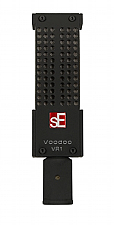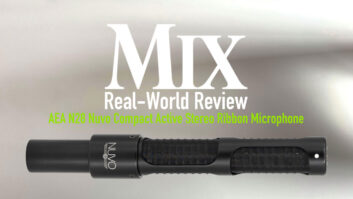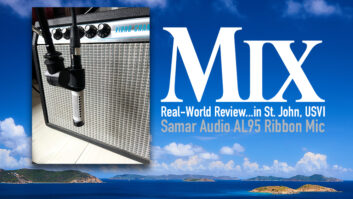

The VR1 (right) and VR2 are both low profile, making it easy to position around instruments.
I don’t hide the fact that I’m a ribbon mic-aholic. The category is rich with manufacturers producing a range of mics—both active and passive—that are all sonically diverse and innovative. One of the later entries into this market is SE Electronics. Based out of Shanghai, China, SE announced a partnership with Rupert Neve Designs in 2008 and soon after released its first active ribbon, the RNR1. The latest ribbon release from SE is the Voodoo line, comprising the VR1 passive and VR2 active models.
Both mics ship in a sturdy wooden box and come with a simple stand mount and fabric sock to protect the ribbon element from environmental damage during setup; an optional shockmount is also available. On the outside, both mics sport a front and back grille with a series of 78 holes split into groups of threes separated by a solid metal piece at the middle. Behind this outer grille, the ribbon element is protected by a fine steel-mesh material. The engines in both mics are the same, but that’s where the similarity ends. The VR2 is active, needs phantom power to operate and has twice the noise as its little brother (20 dB as opposed to 17 dB, A-weighted).
INTO THE STUDIO
My first listen to the VR1 was on a tuba in a small orchestral ensemble. The mic brought plenty of the horn’s low-end personality to the recording while toning down the blattiness at the top end. The VR1’s output is considerably lower than the VR2, so a good preamp is necessary; API Legacy Plus console preamps were just the ticket. In this session, the VR2 was employed on an upright bass placed near the bridge facing up from the floor. Like the VR1, the VR2 had plenty of low-end personality, but the need for gain from the preamp was greatly reduced. Because you don’t have to add a lot of boost on the preamp side, the noise added by the internal electronics of the mic is negated.
Next, I used the mic on various parts of a drum kit. I first heard both the VR1 and VR2 on the outside of the front of a kick drum. I preferred the VR2 in this situation, which seemed to offer a more raw low end that I could pair with a Shure Beta 52 placed inside the drum. The Beta 52 provided the attack while the VR2 ably brought up the low end. I also used it underneath a low tom, which added a great low tone to the top mic’s stick attack.
I’m not usually a big fan of ribbons on lead vocals but I had to see what the Voodoos brought to the mix. In this case, the VR2 was very good at giving me a warm vocal with an extended top that was close to what I was looking for. The top end was further extended later with an EQ plug-in, making it hit the reverb perfectly and sweetening the upper register.
I later had a chance to hear how the VR2 fared against the much more expensive SE RNR1. I had done a voice-over for a Webcast using the RNR1 and now had a chance to try the VR2 for the same application on another project. The VR2 was markedly darker in personality than the RNR1, calling for a cut in the lower mids and an additional EQ boost at 8 kHz to bring it up close to the RNR1’s natural tone.
Both mics were stellar in front of a guitar amp. They are rated the same at 135dB SPL, and I needed little extra EQ after the recording.
WAS IT MAGIC?
The Voodoo VR1 and VR2 mics were a joy to use. Both are sturdily constructed and have a very low profile, offering the ability to put them easily in and around a variety of instruments. From upright bass, drums, percussion, horns, guitar amps and vocals, the mics would give me, at minimum, something I could work with by adding EQ, and at maximum the perfect outcome without having to touch it at all. Both are affordable and street well below their asking price. If I had to pick a favorite, I’d have to go with the VR2. I felt it was more usable over a range of applications and preamps, but that’s not to say I didn’t like the VR1. No matter which you choose, the Voodoo VR1 and VR2 mics are both capable of delivering solid, musical results across a range of applications.
Kevin Becka is
Mix
’s technical editor.

Click on the Product Summary box above to the Voodoo Series product page.







